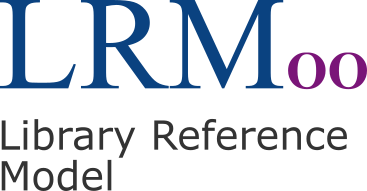LRMoo is a formal ontology intended to capture and represent the underlying semantics of bibliographic information and to facilitate the integration, mediation, and interchange of bibliographic and museum information. LRMoo is designed as an extension to the CIDOC CRM model that aligns with the IFLA Library Reference Model (IFLA LRM), which was approved in August 2017.
LRMoo succeeds and builds on the FRBRoo model, just as IFLA LRM consolidates and succeeds the three models in the IFLA functional requirements family of conceptual models:
- Functional Requirements for Bibliographic Records (FRBR) 1998
- Functional Requirements for Authority Data (FRAD) 2009
- Functional Requirements for Subject Authority Data (FRSAD) 2011.
The FRBR model was originally designed as an entity-relationship model by a study group appointed by the International Federation of Library Associations and Institutions (IFLA) during the period 1991-1997, and was published in 1998. Quite independently, the CIDOC CRM model was being developed starting in 1996 under the auspices of the ICOM CIDOC (International Council for Museums – International Committee on Documentation) Documentation Standards Working Group. The idea that both the library and museum communities might benefit from harmonising their two models was first expressed in 2000 and grew in the following years. Eventually, it led to the formation, in 2003, of the International Working Group on FRBR/CIDOC CRM Harmonisation, to bring together representatives from both communities with the common goals of: a) Expressing the models in the IFLA FRBR family with the concepts, tools, mechanisms, and notation conventions provided by the CIDOC CRM, and: b) Aligning the two object-oriented models with the aim of contributing to the solution of the problem of semantic interoperability between the documentation structures used for library and museum information, such that:
- all equivalent information can be retrieved under the same concepts and
- all directly and indirectly related information can be retrieved regardless of its distribution over individual data sources;
- knowledge encoded for a specific application can be repurposed for other studies;
- recall and precision in systems employed by both communities is improved;
- both communities can learn from each other’s concepts for their mutual progress;
- for the benefit of the scientific and scholarly communities and the general public.
A first draft of FRBRoo was completed in summer 2006. A first official release, 1.0.1, produced a model aligned with FRBR and was completed in January 2010. The next official release, 2.4, was a major expansion encompassing also the concepts in FRAD and FRSAD.
As soon as IFLA LRM was approved in 2017, a working group to update FRBRoo 2.4 to bring it into alignment with IFLA LRM was formed. While this model is a continuation of FRBRoo, it is sufficiently different from FRBRoo to warrant a new name, and so it is called LRMoo to stress its position as a reflection of the IFLA LRM entity-relationship model in an object-oriented formulation. The first official release, 1.0, of LRMoo was fully approved in April 2024.
Pat Riva


